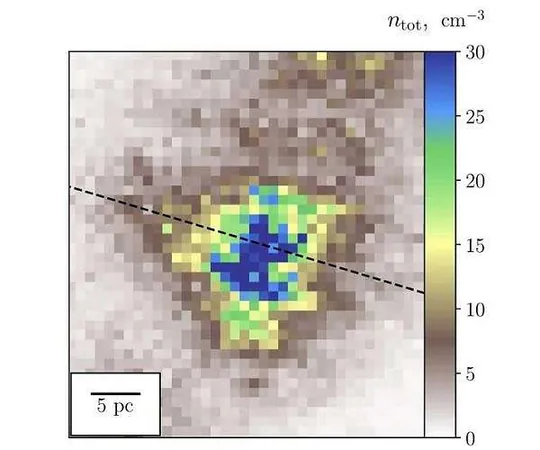
Shocking Discovery: Cosmic-Ray Ionization Rate in the Milky Way Is Ten Times Lower Than Previously Thought!
2024-09-29
Overview of the Study
A groundbreaking study by a team of astrophysicists led by Marta Obolentseva and her colleagues from the Max Planck Institute for Extraterrestrial Physics (MPE) has unveiled a startling revelation: the cosmic-ray ionization rate (CRIR) in our very own Milky Way galaxy is significantly lower than previously estimated—up to ten times less! This pivotal research, published recently, shakes the foundations of our understanding of cosmic phenomena.
Previous Assumptions and Methodology
Previous assumptions about the CRIR, which measures how frequently cosmic rays ionize gas molecules in the interstellar medium, have been dramatically overestimated. Utilizing a combination of observational data from diffuse molecular clouds and cutting-edge models modeling gas and dust distributions, the researchers derived new upper limits for CRIR in nearby molecular clouds. Their findings reveal that long-held beliefs regarding cosmic-ray influences on star formation dynamics were built on inflated estimates.
Implications of Findings
The implications of this finding are monumental. Cosmic rays play a crucial role in shaping the evolution of molecular clouds—regions where stars and potentially planets are born. However, obtaining accurate measurements of the CRIR has always been challenging due to the intricate nature of cosmic ray interactions and the interference from the Solar wind, which makes low-energy cosmic rays, particularly difficult to study.
Data from Voyager Probes
While data from the Voyager probes provided some insight by measuring cosmic rays beyond our heliosphere, it represented only a limited area of the local interstellar medium. Consequently, most CRIR estimates have depended on indirect observations, such as the absorption of ions like H3+, which cosmic rays create through interactions with molecular hydrogen (H2). For years, a significant gap existed between these indirect measurements and what the Voyager data suggested, leading to a persistent scientific puzzle.
Breakthrough from Gaia Satellite
A major breakthrough occurred when the Gaia satellite produced detailed three-dimensional dust extinction maps, illuminating the nuanced distribution of dust and gas in molecular clouds. Armed with this invaluable information, the MPE team re-examined H3+ observations, utilizing sophisticated simulations to model specific cloud structures and their respective CRIRs. Their revised findings now align closely with the CR spectrum measured by Voyager, thus resolving a decade-long discrepancy and calling into question prior estimates.
Comments from Researchers
Lead author Alexei Ivlev remarked, “One of the astonishing outcomes of our analysis is that the re-evaluated values of CRIR are an order of magnitude lower than the previous estimates, which actually brings our results into agreement with the CR spectrum measured by the Voyager probes.”
Related Findings on Gas Densities
Additionally, the research highlighted a related, unexpected finding: earlier estimates of gas densities in diffuse molecular clouds had been over-inflated. Professor David Neufeld from Johns Hopkins University revisited the methods for estimating these densities, correcting errors associated with molecular carbon (C2) excitation rates that led to earlier miscalculations. The adjustments he made aligned gas density estimates with data from the newly available extinction maps.
Reflections on Study Methods
“Initially, I had been quite skeptical of the lower density estimates that emerged; they flew in the face of prior understanding,” Neufeld reflected. “But a deeper examination of our previous methods explained their inaccuracies, prompting a necessary reevaluation.”
Impact of New Estimates
The repercussions of these new CRIR and gas density values will significantly impact our grasp of molecular clouds, star formation processes, and the overarching dynamics governing our galaxy.
Wider Implications by Experts
Paola Caselli, director at the Center for Astrochemical Studies at MPE, emphasized the broader relevance of their findings, stating, “Cosmic rays are fundamental to the dynamical evolution of interstellar molecular clouds, where stars and planets form, as well as to the chemical evolution that fosters the precursors of pre-biotic molecules in space. Determining the actual CRIR is critical for both astrophysics and astrochemistry, making this a priority in astrological research.”
Call for Reevaluation
As the scientific community responds to these findings, an urgent call for the re-evaluation of prior CRIR estimates in molecular clouds is underway, ensuring that we refine our understanding of gas distribution throughout the Milky Way.
Conclusion
Stay tuned as we continue to unravel the mysteries of the universe and the delicate balance of forces that shape it!



 Brasil (PT)
Brasil (PT)
 Canada (EN)
Canada (EN)
 Chile (ES)
Chile (ES)
 España (ES)
España (ES)
 France (FR)
France (FR)
 Hong Kong (EN)
Hong Kong (EN)
 Italia (IT)
Italia (IT)
 日本 (JA)
日本 (JA)
 Magyarország (HU)
Magyarország (HU)
 Norge (NO)
Norge (NO)
 Polska (PL)
Polska (PL)
 Schweiz (DE)
Schweiz (DE)
 Singapore (EN)
Singapore (EN)
 Sverige (SV)
Sverige (SV)
 Suomi (FI)
Suomi (FI)
 Türkiye (TR)
Türkiye (TR)